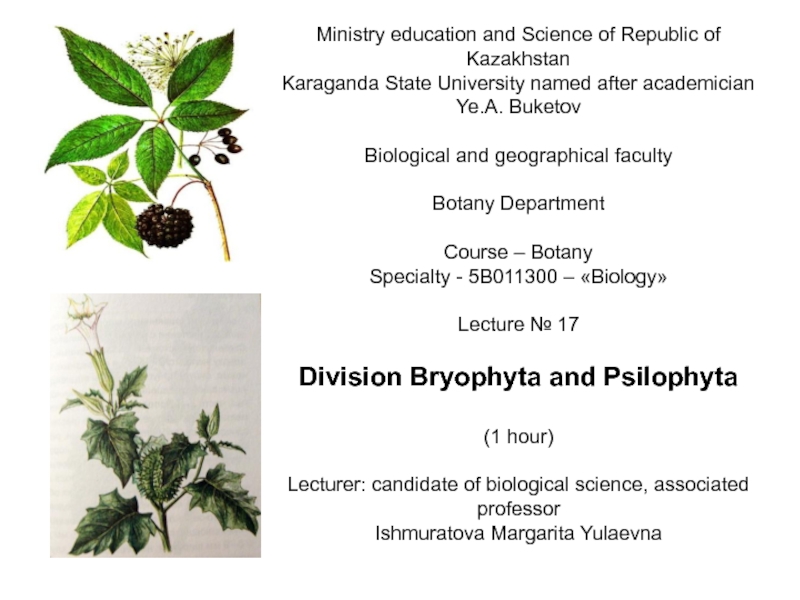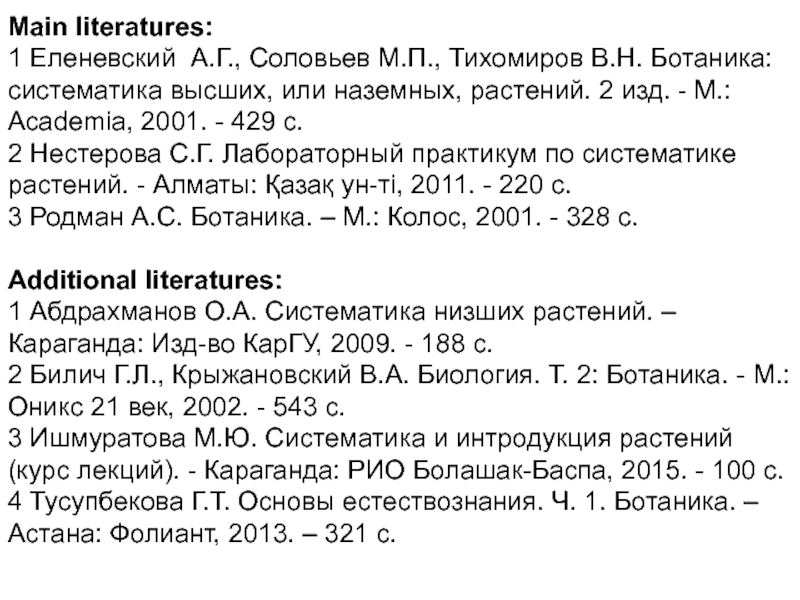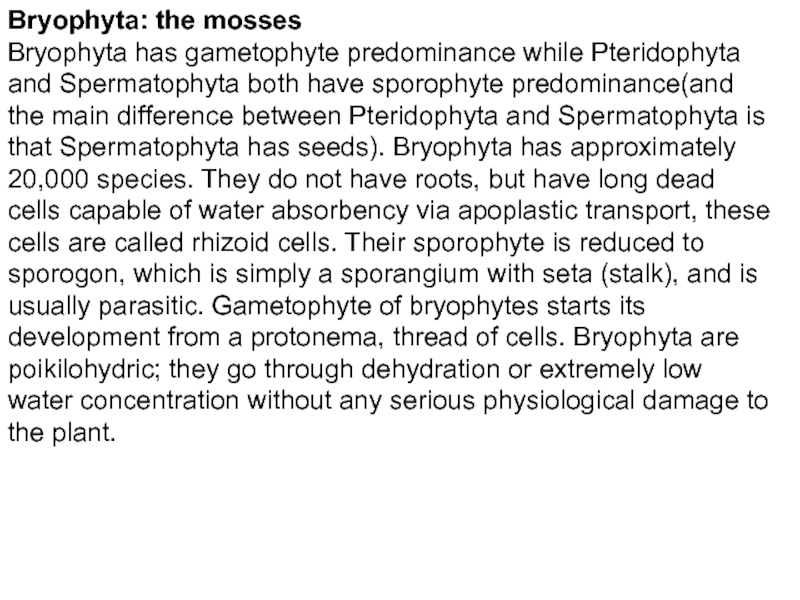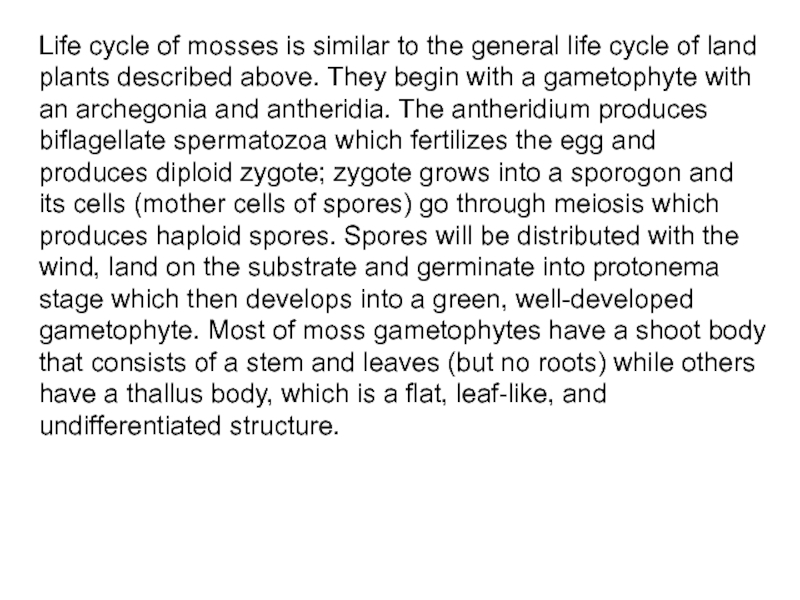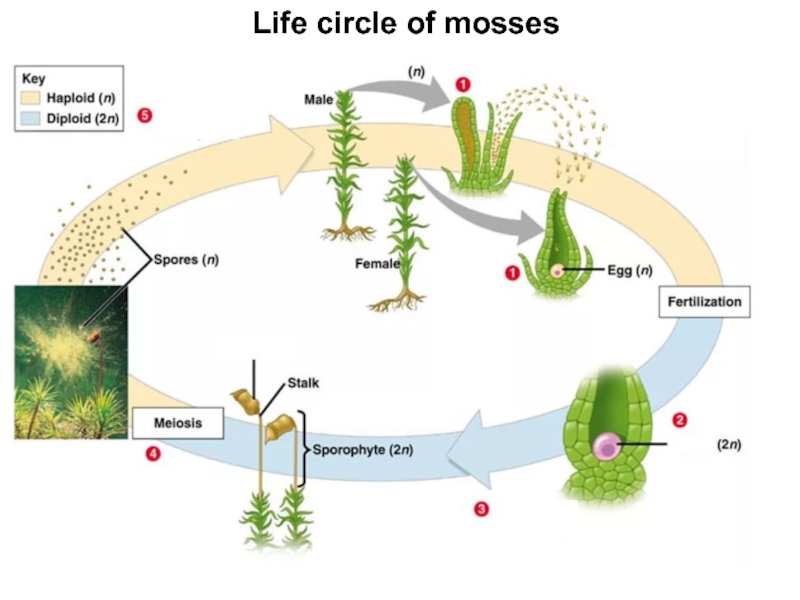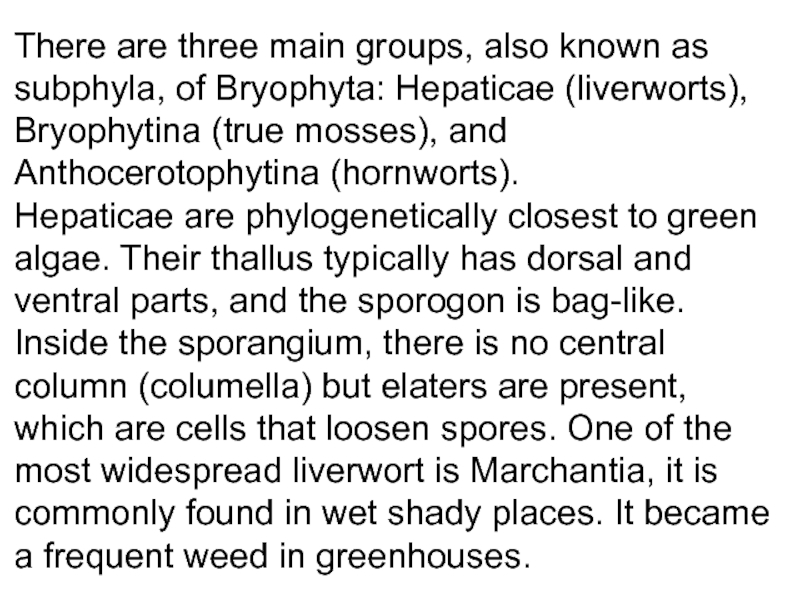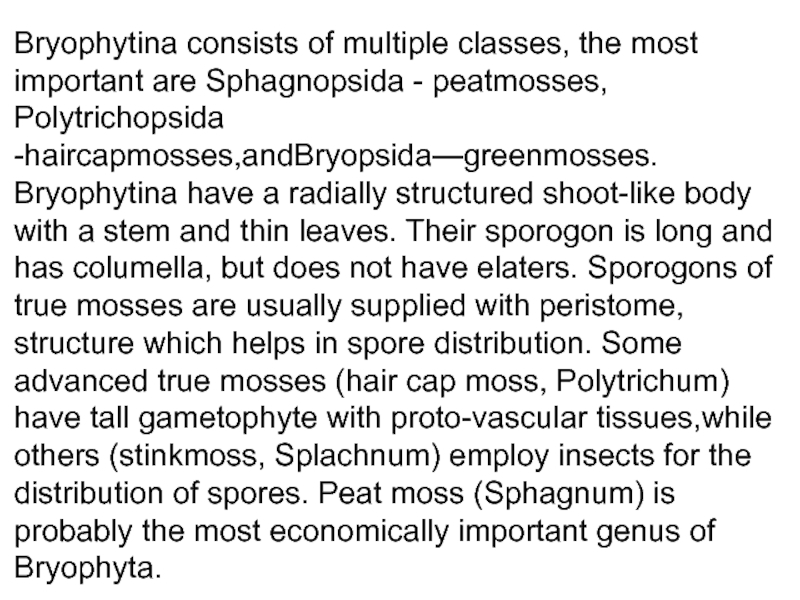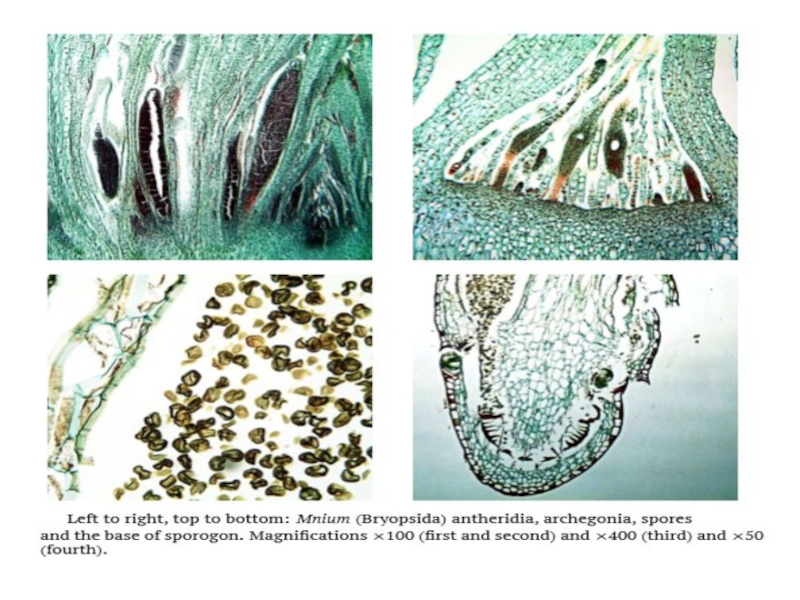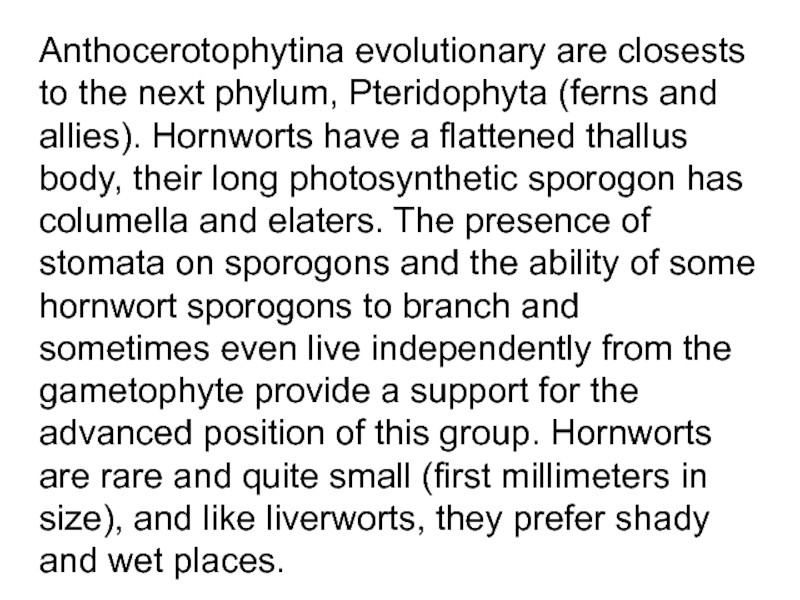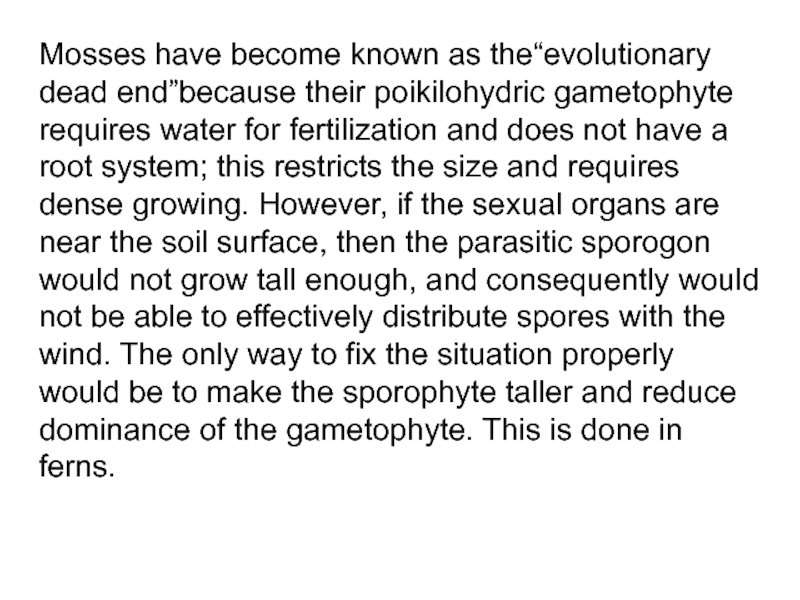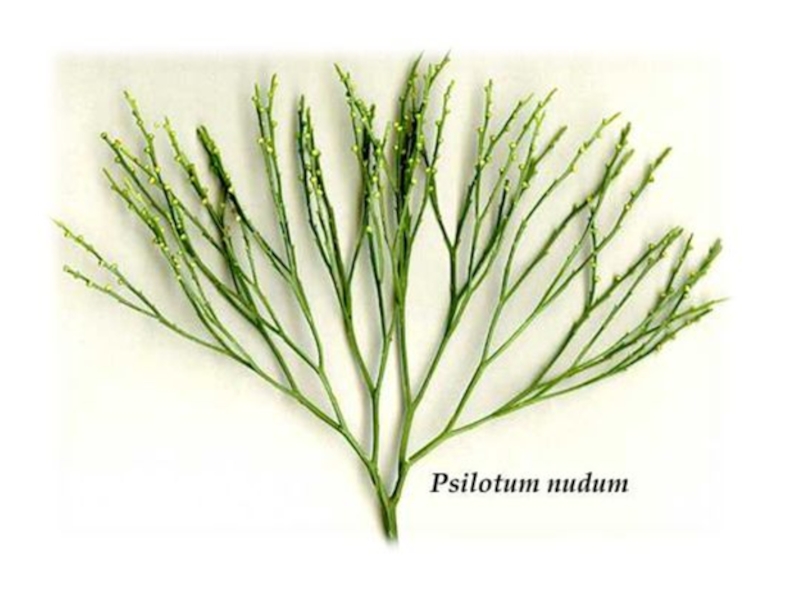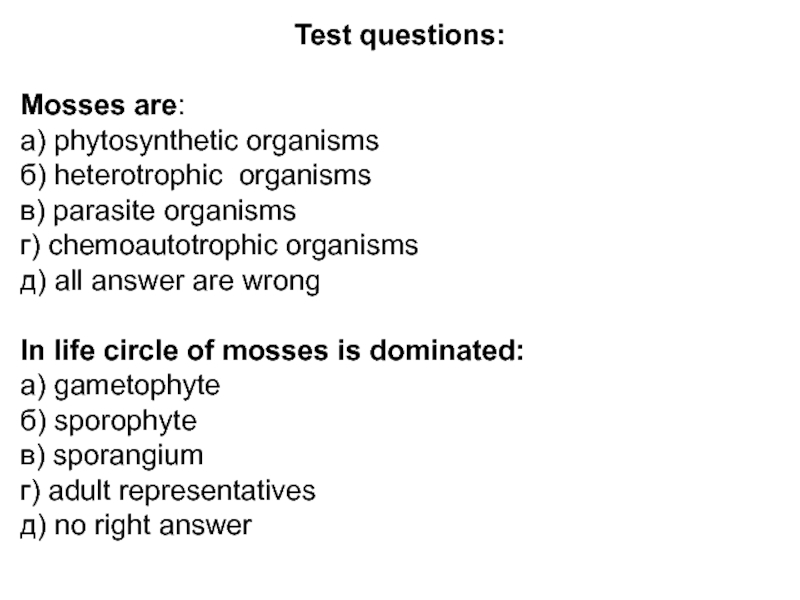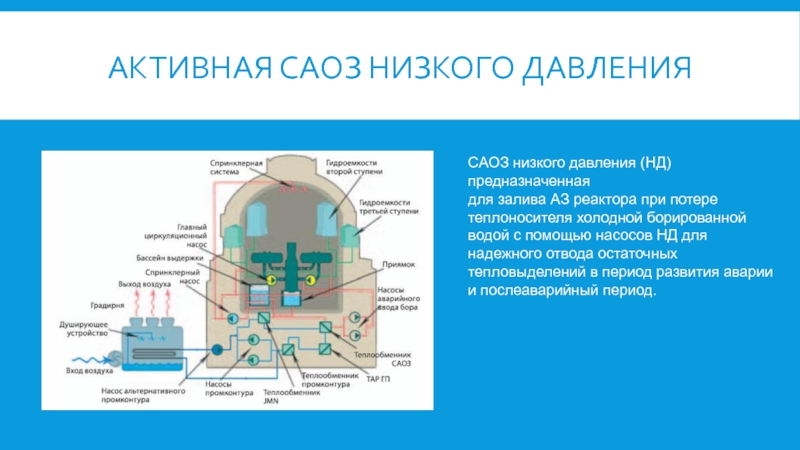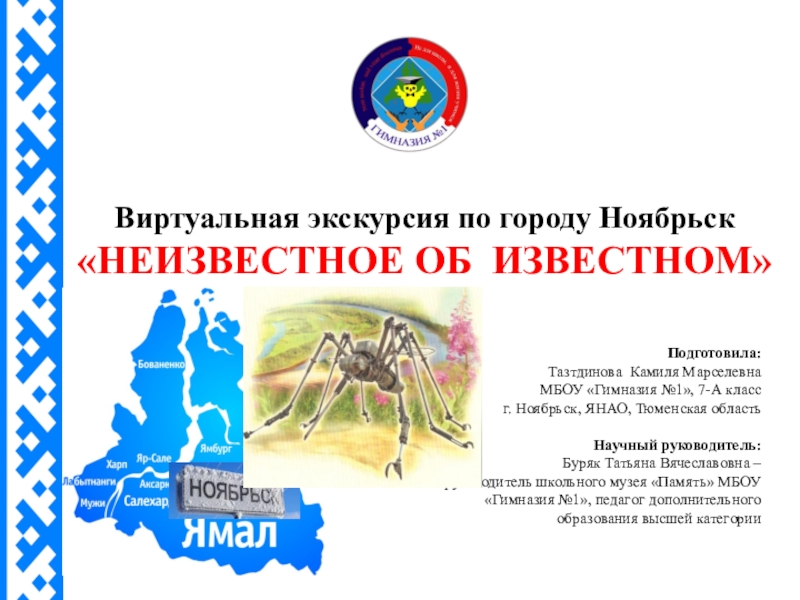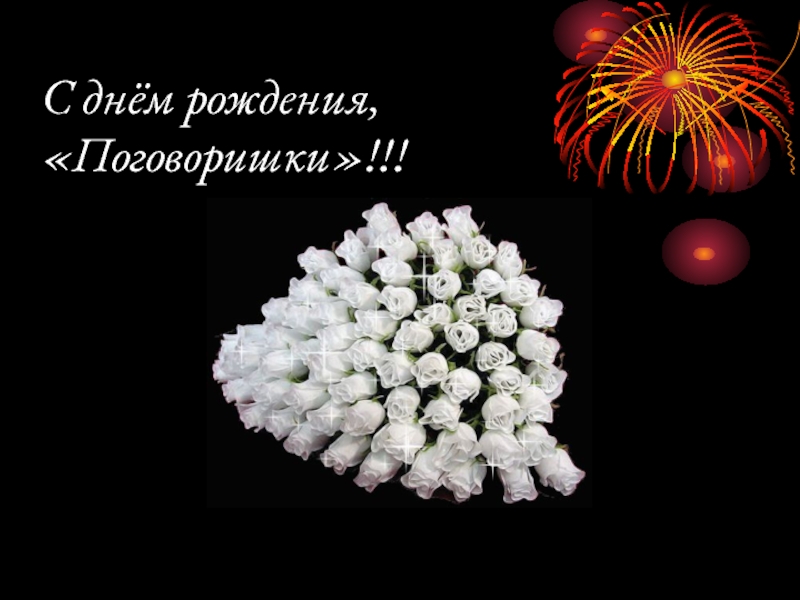Слайд 1Ministry education and Science of Republic of Kazakhstan
Karaganda State University
named after academician Ye.A. Buketov
Biological and geographical faculty
Botany Department
Course – Botany
Specialty - 5В011300 – «Biology»
Lecture № 17
Division Bryophyta and Psilophyta
(1 hour)
Lecturer: candidate of biological science, associated professor
Ishmuratova Margarita Yulaevna
Слайд 2Plan of lecture:
1 General characteristic of mosses.
2 Class Hepatic and
Antracenic moses.
3 Class Bryopsida.
4 Division Psilophytes.
Слайд 3Main literatures:
1 Еленевский А.Г., Соловьев М.П., Тихомиров В.Н. Ботаника:
систематика высших, или наземных, растений. 2 изд. - М.: Academіa,
2001. - 429 с.
2 Нестерова С.Г. Лабораторный практикум по систематике растений. - Алматы: Қазақ ун-ті, 2011. - 220 с.
3 Родман А.С. Ботаника. – М.: Колос, 2001. - 328 с.
Additional literatures:
1 Абдрахманов О.А. Систематика низших растений. – Караганда: Изд-во КарГУ, 2009. - 188 с.
2 Билич Г.Л., Крыжановский В.А. Биология. Т. 2: Ботаника. - М.: Оникс 21 век, 2002. - 543 с.
3 Ишмуратова М.Ю. Систематика и интродукция растений (курс лекций). - Караганда: РИО Болашак-Баспа, 2015. - 100 с.
4 Тусупбекова Г.Т. Основы естествознания. Ч. 1. Ботаника. – Астана: Фолиант, 2013. – 321 с.
Слайд 4Bryophyta: the mosses
Bryophyta has gametophyte predominance while Pteridophyta and Spermatophyta
both have sporophyte predominance(and the main difference between Pteridophyta and
Spermatophyta is that Spermatophyta has seeds). Bryophyta has approximately 20,000 species. They do not have roots, but have long dead cells capable of water absorbency via apoplastic transport, these cells are called rhizoid cells. Their sporophyte is reduced to sporogon, which is simply a sporangium with seta (stalk), and is usually parasitic. Gametophyte of bryophytes starts its development from a protonema, thread of cells. Bryophyta are poikilohydric; they go through dehydration or extremely low water concentration without any serious physiological damage to the plant.
Слайд 5Life cycle of mosses is similar to the general life
cycle of land plants described above. They begin with a
gametophyte with an archegonia and antheridia. The antheridium produces biflagellate spermatozoa which fertilizes the egg and produces diploid zygote; zygote grows into a sporogon and its cells (mother cells of spores) go through meiosis which produces haploid spores. Spores will be distributed with the wind, land on the substrate and germinate into protonema stage which then develops into a green, well-developed gametophyte. Most of moss gametophytes have a shoot body that consists of a stem and leaves (but no roots) while others have a thallus body, which is a flat, leaf-like, and undifferentiated structure.
Слайд 8There are three main groups, also known as subphyla, of
Bryophyta: Hepaticae (liverworts), Bryophytina (true mosses), and Anthocerotophytina (hornworts).
Hepaticae are
phylogenetically closest to green algae. Their thallus typically has dorsal and ventral parts, and the sporogon is bag-like. Inside the sporangium, there is no central column (columella) but elaters are present, which are cells that loosen spores. One of the most widespread liverwort is Marchantia, it is commonly found in wet shady places. It became a frequent weed in greenhouses.
Слайд 9Bryophytina consists of multiple classes, the most important are Sphagnopsida
- peatmosses, Polytrichopsida -haircapmosses,andBryopsida—greenmosses. Bryophytina have a radially structured shoot-like
body with a stem and thin leaves. Their sporogon is long and has columella, but does not have elaters. Sporogons of true mosses are usually supplied with peristome, structure which helps in spore distribution. Some advanced true mosses (hair cap moss, Polytrichum) have tall gametophyte with proto-vascular tissues,while others (stinkmoss, Splachnum) employ insects for the distribution of spores. Peat moss (Sphagnum) is probably the most economically important genus of Bryophyta.
Слайд 11Anthocerotophytina evolutionary are closests to the next phylum, Pteridophyta (ferns
and allies). Hornworts have a flattened thallus body, their long
photosynthetic sporogon has columella and elaters. The presence of stomata on sporogons and the ability of some hornwort sporogons to branch and sometimes even live independently from the gametophyte provide a support for the advanced position of this group. Hornworts are rare and quite small (first millimeters in size), and like liverworts, they prefer shady and wet places.
Слайд 13Mosses have become known as the“evolutionary dead end”because their poikilohydric
gametophyte requires water for fertilization and does not have a
root system; this restricts the size and requires dense growing. However, if the sexual organs are near the soil surface, then the parasitic sporogon would not grow tall enough, and consequently would not be able to effectively distribute spores with the wind. The only way to fix the situation properly would be to make the sporophyte taller and reduce dominance of the gametophyte. This is done in ferns.
Слайд 15Psilotopsida (whisk ferns) is a small tropical group which consists
of only two genera,Psilotum and Tmesipteris,with only seven different species.
They are herbaceous plants that grow as epiphytes. Whisk ferns are homosporous, and their sporangia are fused into synangia. Psilotopsida have protostele like the some lycophytes,and long-lived underground gametophytes; they also have multiflagellate spermatozoa similar to all other ferns. Both Psilotum and Tmesipteris lack roots; in addition, Psilotum also lacks leaves.
Слайд 17Control questions:
1 Which generation is dominated for mosses?
2 What
is the main difference between mosses and psilophytes?
3 Where does
sporophyte develop at mosses?
4 Describe the life circle of psilophytes.
5 How do mosses and psilophytes reproduce?
Слайд 18Test questions:
Mosses are:
а) phytosynthetic organisms
б) heterotrophic organisms
в) parasite
organisms
г) chemoautotrophic organisms
д) all answer are wrong
In
life circle of mosses is dominated:
а) gametophyte
б) sporophyte
в) sporangium
г) adult representatives
д) no right answer
